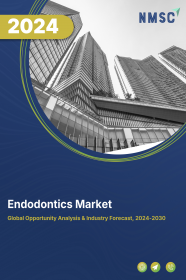
Osseointegration Implants Market by Product (Bone-Anchored Prostheses and Dental Implants), by Material (Metallic, Ceramic, Polymeric, and other Biomaterials), and by End Users (Hospitals, Dental Clinics and Ambulatory Surgical Clinics)- Global Opportunity Analysis and Industry Forecast, 2024 – 2030
Market Definition
The global Osseointegration Implants Market size was valued at USD 8.02 billion in 2023 and is predicted to reach USD 13.84 billion by 2030 with a CAGR of 8.1% from 2024-2030. Osseointegration is a fundamental biological process essential for the successful integration of medical implants, such as dental implants and prosthetic limbs, into the body. It involves the direct structural and functional connection formed between the implant surface and surrounding bone tissue, ensuring stable support and functionality of the implant. Functional ankylosis relies on factors such as implant design, bone quality, and surgical precision, and it significantly improves patient outcomes by facilitating secure attachment of implants and enhancing mobility and comfort for individuals with limb loss.
Market Dynamics and Trends
The global osseointegration implants market is witnessing significant growth, driven by the increasing prevalence of dental and orthopedic conditions requiring implant-based treatments. The increasing prevalence of dental and orthopedic conditions requiring implant-based treatments.
Factors such as aging populations, rising incidence of dental diseases, and musculoskeletal disorders contribute to the growing demand for osseointegration implants worldwide. As the population ages and lifestyles change, there is a greater need for durable and long-lasting solutions to restore dental function and mobility, spurring the functional ankylosis market growth.
Moreover, technological advancements and innovations in implant materials and designs are fueling the osseointegration implants market expansion. Continuous research and development efforts have led to the introduction of advanced implant materials, such as titanium alloys and ceramic materials, which offer superior biocompatibility and durability.
Additionally, improvements in implant surface modifications and manufacturing techniques enhance osseointegration rates and implant stability, driving adoption among healthcare providers and patients alike.
Furthermore, the increasing adoption of minimally invasive surgical techniques and digital dentistry technologies is propelling market growth. Minimally invasive approaches reduce patient discomfort, shorten recovery times, and improve treatment outcomes, making implant procedures more attractive to patients and healthcare providers.
Similarly, advancements in digital dentistry, such as computer-aided design and manufacturing (CAD/CAM) technology, enable precise implant planning and placement, enhancing treatment predictability and patient satisfaction.
However, the high costs associated with implant procedures, risks and complications involved in osteointegration dental implant surgery such as never damage, implant rejection, and infection are the factors restraining the growth of the osseointegration implants market.
On the contrary, the introduction of computer-guided implant surgery as it allows a doctor to accurately place an implant and further increases predictability is expected to create ample growth opportunities for the market in the coming years.
Market Segmentations and Scope of the Study
The osseointegration implants market share is segmented based on product, material, end user, and geography. Based on product, the market is classified into bone-anchored prostheses and dental implants. Bone anchored prostheses market is further sub-segmented into hip implants, knee implants, and spinal implants. Based on dental implants, the market is sub-segmented into crowns and abutments. Based on material, the market is divided into metal, ceramic, polymer, and other biomaterials. Based on end users, the market is categorized into hospitals, ambulatory surgical centers, and dental clinics. Geographic breakdown and analysis of each of the aforesaid segments includes regions comprising of North America, Europe, Asia-Pacific, and RoW.
Geographical Analysis
North America holds the Dominant share of the osseointegration implants market trends and is poised to maintain its dominance in the forecast period. This leadership is attributed to a significant proportion of the population comprised of older adults. This portion of the population is more prone to bone-related disorders and injuries necessitating osseointegration implants for surgical interventions.
According to the Population Reference Bureau, the number of Americans aged 65 and older is projected to increase from 58 million in 2022 to 82 million by 2050, marking a 47% increase. Moreover, the 65-and-older age group's share of the total population is expected to rise from 17% to 23%. This demographic trend underscores the substantial demand for osseointegration implants in North America.
Moreover, North America boasts a well-established healthcare infrastructure, complemented by substantial healthcare expenditure by the government. The region's robust healthcare system facilitates the adoption of advanced osseointegration implant procedures by public healthcare providers.
For instance, the U.S. Department of Agriculture (USDA) Rural Development recently announced grants totaling $74 million to improve healthcare facilities in rural towns across the nation. These grants aim to support 143 rural healthcare organizations in expanding critical services, including those related to orthopedic surgeries requiring osseointegration implants. Such initiatives underscore the commitment to enhancing healthcare accessibility and quality in North America.
On the other hand, Europe is anticipated to experience a steady rise in the osseointegration implants market, primarily driven by the high number of hip and knee replacement surgeries conducted in the region. Notably, countries such as Germany, Switzerland, Austria, Finland, and Belgium have been identified by the Organization for Economic Cooperation and Development (OECD) as having among the highest rates of hip and knee replacement surgeries globally in 2022.
This prevalence underscores the substantial demand for osseointegration implants in Europe, as these surgeries often require the use of such implants for optimal outcomes. Moreover, the presence of major key players in the region, including Institut Straumann AG, Camlog, Integrum SE, and Smith and Nephew Plc., further accelerates the adoption of osseointegration implants and drives market growth.
For example, in May 2022, the Straumann Group, the parent company of Institut Straumann AG, acquired PlusDental, a move aimed at enhancing its presence in countries like the Netherlands, Sweden, and the UK through PlusDental's extensive network of clinics across Europe. Such strategic acquisitions and collaborations strengthen the market position of key players and expand their market reach, facilitating greater accessibility to osseointegration implants across Europe.
Additionally, Europe's favorable regulatory environment and stringent quality standards ensure the safety and efficacy of osseointegration implants, fostering confidence among healthcare providers and patients alike. Stringent regulations governing medical devices and implants promote the adoption of advanced technologies and materials that enhance osseointegration outcomes, driving market growth in the region.
Competitive Landscape
The osseointegration implants industry comprises of various market players such as Zimmer Biomet Holdings Inc, Dentsply Sirona, Bicon LLC, Institut Straumann AG, Camlog, Osstem Implant, Integrum SE, Smith and Nephew Plc., Henry Schein Inc. and Danaher Corporation. These market players are adopting various joint venture strategies and completing acquisitions various regions to maintain their dominance in the osseointegration implants market.
For instance, 2022, Dentsply Sirona had announced a partnership with The Platform for Better Oral Health in Europe. Under this collaboration, Dentsply Sirona aimed to improved oral health and enhance cost-effective prevention of oral diseases in Europe by providing oral health education, promotion, and access to dental care across all Europe.
Moreover, in 2020, Zimmer Biomet Holdings Inc. announced that it acquired A&E Medical Corporation for 150 million US dollar. This acquisition will help Zimmer Biomet to expand its product portfolio and offer a comprehensive suite of sternal closure products such as sternal sutures, cable systems and rigid fixation.
Furthermore, in July 2020, Osstem Implant announced a global partnership with 3shape to enhance its digital dentistry portfolio. Under this collaboration, Osstem will be able to strengthen its distributor network and it will further help Osstem to provide better and advance implant technology to its customers using 3sapes digital dentistry solutions.
Key Benefits
-
The osseointegration implants market report provides a quantitative analysis of the current market and estimations through 2024-2030 that assist in identifying the prevailing market opportunities to capitalize on.
-
The study comprises a deep dive analysis of the current and future osseointegration implants market trends for depicting the prevalent investment pockets in the market.
-
The information related to key drivers, restraints, and opportunities and their impact on the osseointegration implants market is provided in the report.
-
The competitive analysis of the market players along with their market share in the osseointegration implants market.
-
The SWOT analysis and Porter's Five Forces model are elaborated in the study.
-
Value chain analysis in the market study provides a clear picture of the stakeholders’ roles.
Osseointegration Implants Market Key Segments
By Product
-
Bone Anchored Prostheses
-
Hip Implants
-
Knee Implants
-
Spinal Implants
-
-
Dental Implants
-
Crown
-
Abutment
-
By Material
-
Metal
-
Ceramic
-
Polymer
-
Other Biomaterials
By End User
-
Hospital
-
Ambulatory Surgical Centers
-
Dental Clinics
By Geography
-
North America
-
The U.S.
-
Canada
-
Mexico
-
-
Europe
-
The U.K.
-
Germany
-
France
-
Italy
-
Spain
-
Denmark
-
Netherlands
-
Finland
-
Sweden
-
Norway
-
Russia
-
Rest of Europe
-
-
Asia-Pacific
-
China
-
Japan
-
India
-
South Korea
-
Australia
-
Indonesia
-
Singapore
-
Taiwan
-
Thailand
-
Rest of Asia-Pacific
-
-
Rest of the World (RoW)
-
Latin America
-
Middle East
-
Africa
-
Key Players
-
Zimmer Biomet Holdings Inc
-
Dentsply Sirona
-
Bicon LLC
-
Institut Straumann AG
-
Camlog
-
Osstem Implant
-
Integrum SE
-
Smith and Nephew Plc.
-
Henry Schein Inc.
-
Danaher Corporation
REPORT SCOPE AND SEGMENTATION:
|
Parameters |
Details |
|
Market Size in 2023 |
USD 8.02 Billion |
|
Revenue Forecast in 2030 |
USD 13.84 Billion |
|
Growth Rate |
CAGR of 8.1% from 2024 to 2030 |
|
Analysis Period |
2023–2030 |
|
Base Year Considered |
2023 |
|
Forecast Period |
2024–2030 |
|
Market Size Estimation |
Billion (USD) |
|
Growth Factors |
|
|
Countries Covered |
28 |
|
Companies Profiled |
10 |
|
Market Share |
Available for 10 companies |
|
Customization Scope |
Free customization (equivalent to up to 80 working hours of analysts) after purchase. Addition or alteration to country, regional, and segment scope. |
|
Pricing and Purchase Options |
Avail customized purchase options to meet your exact research needs. |




















 Speak to Our Analyst
Speak to Our Analyst





















